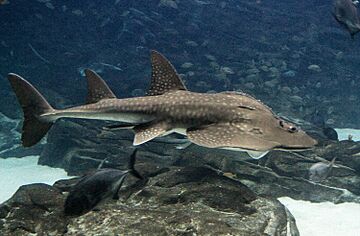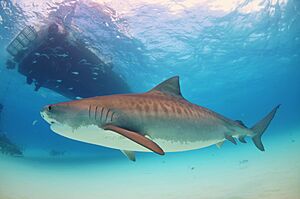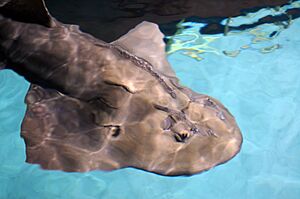Bowmouth guitarfish facts for kids
Quick facts for kids Bowmouth guitarfish |
|
|---|---|
 |
|
| Conservation status | |
| Scientific classification | |
 |
|
| Range of Rhina ancylostoma | |
| Synonyms | |
|
Rhina cyclostomus Swainson, 1839 |
The bowmouth guitarfish (Rhina ancylostoma), also called the shark ray or mud skate, is a special type of ray. It belongs to the family called Rhinidae. This rare fish lives in the warm, coastal waters of the western Indo-Pacific region. You can find it in depths of up to 90 meters (295 feet).
The bowmouth guitarfish looks very unique. It has a wide, thick body with a rounded snout. Its dorsal and tail fins look like a shark's. Its mouth is shaped like a "W", and it has many thorny ridges on its head and back. The top of its body is bluish-gray to brown with many white spots. It also has two big black marks above its pectoral fins. This large ray can grow up to 2.7 meters (9 feet) long and weigh as much as 135 kilograms (298 pounds).
This ray usually lives near the sea floor, preferring sandy or muddy areas close to underwater structures. It is a strong swimmer and hunts bony fishes, crustaceans (like crabs), and molluscs. The bowmouth guitarfish gives live birth to two to eleven babies at a time. The babies grow inside the mother, getting food from a yolk. The International Union for Conservation of Nature (IUCN) says this species is Critically Endangered. This is because it is often caught by fishermen for its valuable fins and meat. Losing its habitat also makes it harder for this ray to survive. Luckily, the bowmouth guitarfish does well in aquariums and can be seen in many public aquariums.
Contents
What's in a Name?
Scientists Marcus Elieser Bloch and Johann Gottlob Schneider first described the bowmouth guitarfish in 1801. They named it Rhina ancylostoma. The name Rhina comes from an old Greek word meaning "snout." The second part, ancylostoma, means "curved mouth" in Greek. This name perfectly describes its unique mouth shape!
People also call this ray by other names, like shark ray or mud skate. Scientists are still learning about how the bowmouth guitarfish is related to other rays. It seems to be closely related to "wedgefishes," which are also rays with large, shark-like fins.
Appearance and Features
The bowmouth guitarfish is a very big and strong fish. It can grow to be about 2.7 meters (9 feet) long and weigh up to 135 kilograms (298 pounds). Its head is short, wide, and flat, with a round snout. Its eyes are medium-sized, and it has large spiracles (holes for breathing) behind them. The mouth is W-shaped, and its teeth are flat and blunt, perfect for crushing hard-shelled prey. It has five pairs of gill slits on its underside.
This ray has two tall, sickle-shaped dorsal fins on its back. The first dorsal fin is bigger than the second. Its large, triangular pectoral fins have a deep curve where they meet the head. The pelvic fins are much smaller, and it does not have an anal fin. Its tail is long and ends in a big, crescent-shaped caudal fin.
The top of the ray's body feels rough, like sandpaper, because it's covered in tiny dermal denticles (skin teeth). It has a thick ridge along its back with sharp thorns. There are also thorny ridges near its eyes and on its "shoulders." The ray is bluish to brownish-gray on top, with white spots all over its body and fins. It has a black mark with a white edge above each pectoral fin. Young rays have brighter colors and clearer patterns than older ones.
Where They Live
The bowmouth guitarfish lives in the warm, coastal waters of the western Indo-Pacific. You can find it from South Africa, through the Red Sea, across India and Southeast Asia, all the way to Australia, Korea, and southern Japan.
This ray usually stays close to the sea floor, in depths between 3 and 90 meters (10 to 295 feet). It likes sandy or muddy places. You might also spot it near rocky areas, coral reefs, or even shipwrecks.
Life and Habits
The bowmouth guitarfish is a powerful swimmer, moving its tail like a shark to propel itself. It is usually more active at night. This ray mainly eats fish that live near the bottom, like croakers, and crustaceans such as crabs and shrimp. It also eats bivalves (like clams) and cephalopods (like squid). Its strong, flat teeth help it crush the shells of its prey.
The tiger shark is known to hunt the bowmouth guitarfish. The ray's thorny skin helps protect it from predators. Sometimes, it might even ram things it sees as a threat.
When it comes to having babies, the bowmouth guitarfish gives live birth. The mother carries the developing babies inside her, and they get their food from a yolk sac. A mother can have anywhere from two to eleven babies at a time. Newborns are about 45 to 51 centimeters (18 to 20 inches) long. Males become adults when they are about 1.5 to 1.8 meters (5 to 6 feet) long, and females become adults when they are over 1.8 meters (6 feet) long. Females usually grow larger than males.
Bowmouth Guitarfish and Humans
People catch the bowmouth guitarfish, sometimes on purpose and sometimes by accident. Fishermen use trawls, gillnets, and fishing lines. The fins of this ray are very valuable because they are used in shark fin soup. Often, only the fins are kept and sold. However, the meat can also be sold fresh or dried and salted, and it is popular in places like India.
When caught by accident in fishing nets, the bowmouth guitarfish can be a problem. It's strong and has rough skin, making it hard to handle. When it thrashes around in the net, it can damage other fish caught. In Thailand, people even use the ray's large thorns to make bracelets.
The International Union for Conservation of Nature (IUCN) has listed the bowmouth guitarfish as Critically Endangered. This means it is at a very high risk of disappearing. Fishing is a big threat, as is the destruction of its habitat. Things like blast fishing, coral bleaching, and siltation harm its home. Its numbers have dropped a lot in some areas, like Indonesia, where it is often caught by unregulated fishing. Because it is rare and faces many dangers, some people call the bowmouth guitarfish "the panda of the aquatic world."
This ray is a popular animal in public aquariums because it adapts well to living in captivity. One ray even lived for seven years in an aquarium! In 2007, the Newport Aquarium in Kentucky started the first program to breed these rays in captivity. In 2014, a female named "Sweet Pea" gave birth to seven pups, though sadly, they did not survive. But in 2016, Sweet Pea had nine more pups, and they were healthy and growing! These pups were later moved to a coral reef exhibit where visitors could see them. The S.E.A. Aquarium in Singapore also successfully bred this species in 2015.
Images for kids







